|
After Lunch You will drive through the Diplomatic Enclave, the Maidan lined with palaces & Government buildings to the Presidential Palace, India Gate, and other monuments designed by Sir Edwin Lutyens (open daily).
Humayun's Tomb
The most important early Mughal monument in Delhi, it is an outstanding landmark in the development of Mughal style. The red sandstone and marble garden tomb set the pattern for Mughal mausoleums that culminated in the Taj at Agra. Nine years after his death,
the most important early Mughal monument in Delhi was built by his senior widow,
Haji Begum : An outstanding landmark in the development of Mughal style, the red sandstone and marble garden tomb set the pattern for Mughal mausoleums that culminated in the Taj Mahal at Agra. An ornamental gateway piercing a high wall leads to a formal garden, where the domed memorial is set on a broad podium. It was constructed 1565-71 to designs by the Persian architect Mirak Mirza Ghiyas who applied the spatial concepts of Timurid and Safavid architecture to local architectural forms and materials. He also introduced the important Mughal double dome whose two skins resolve the problem of achieving a lofty exterior while keeping the internal proportions in balance. Among the other Mughal royals buried here is Dara Sikoh, Shah Jahan's favorite son. Outside the gateway are nobleman Isa Khan's octagonal Lodi-style tomb, and a row of dormitories, probably the living quarters of the Persian craftsmen working on the mausoleum.-
Continue your tour to visit the Qutab Minar, a soaring tower of victory commenced in AD 1199 and 10 miles south of New Delhi. In 1206, the great builder and former slave Qutab-Ud-din Aibak proclaimed himself the first Sultan of Delhi. He had been governor since 1191. This Sultanate period, under various dynasties, lasted until 1526. Aibak's Slave dynasty (1191-1246) marks the start of the all pervading Islamic influence in India and laid the foundations of the future Imperial style of Islamic architecture. Aibak built the exquisitely carved, red sandstone five story towers, the Qutab Minar. One of the symbols of Delhi it is in fact modeled on the tower at Gazni. The Qutab (pole, axis) signified the pivot of justice, sovereignty and of course the Islamic faith-a highly symbolic tower of victory. Originally more than its current 72.55m in height, it was also a handy minaret for the muezzin to call the faithful to the mosque.
After sightseeing return to your hotel.
Special Dinner at Restaurant. Overnight at Hotel.
Day 03 : Delhi � Agra
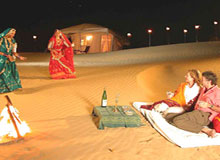 After breakfast drive to Agra (approximately 220 kms / 4 � 5 hrs). The Highway to Agra has recently been modernized and is a four lane divided highway with a number of midway restaurants to unwind you.
After breakfast drive to Agra (approximately 220 kms / 4 � 5 hrs). The Highway to Agra has recently been modernized and is a four lane divided highway with a number of midway restaurants to unwind you.
The First landmark on the horizon of Agra city is the serene monument of Sikandra � the mausoleum of Mughal Emperor Akbar which he himself started constructing but was completed in 1613 during the reign of Jehangir who made some modifications to its original design and added the top terrace with marble cloisters containing a false grave of the emperor.
Later continue on to Agra and checking at Hotel. Upon arrival at hotel. Lunch at Hotel.
Sun set visit to the TAJ MAHAL, (Taj Mahal is closed on Friday ) One of the seven wonders of the world, built by the Moghul Emperor Shahjehan, this beautiful mausoleum is built of pure white marble and is an architectural marvel. Built in the memory of his beloved queen Mumtaz Mahal the construction of this architectural marvel took over 22 years and required almost 20000 laborers. Stainless white marble was excavated from the mines at Makrana, sandstone was brought from Fatehpur Sikri and precious and semi precious stones were chosen from across the globe. The building was conceived as a garden tomb with the mausoleum rising at the far end of the complex with the river Yamuna flowing below.
Beneath the dome are the cenotaphs of Mumtaz Mahal and Shah Jehan. Reaching a height of almost 75 metres, the Taj Mahal with its luminous exterior is a monument of many moods with light effects playing different roles with the gradual passage of the day.
After visiting Taj Mahal return to hotel. Dinner with folk Dances & Puppet Show at City Restaurant. Overnight stay.
Day 04 : Depart For Jaipur
After breakfast continue the sightseeing among the other important landmarks of the Moghul era are the Red Fort, built by Emperor Akbar over the years 1565 � 1573 with its maze of courtyards, mosques, and private chambers which reflect the skills of the ancient Indian architects and artisans. Most of the buildings originally built by Akbar were destroyed and were replaced by his grandson Shah Jehan. The only surviving structure from Akbar�s period apart from the solid sand stone ramparts and the gateway is the Jehangir Mahal. It is the biggest private residence in the complex and its architecture indicates strong influences from Hindu overtones. The Diwan-I-Khas which is the exclusive hall of private audience was built by Shah Jehan. It is here that the famous Takht � E � Taus was kept before it was moved to Delhi. Nearby are the various buildings which were built by Shah Jehan including the Khas Mahal, The Jasmine Towers, the Octagonal Tower, the Sheesh Mahal, and the Hamam�s. Ironically it was within these apartments that Shah Jehan spent his last years when he was imprisoned by his son Aurangzeb.
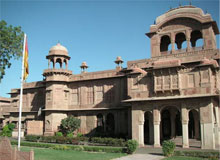 Later drive to Jaipur ( approxiamate 245 Kms 5 � 6 Hrs ) enroute visiting the deserted capital of the Mughal empire at Fatehpur Sikri. Located approximately 36 kms / 1 hours drive away the town was built by the Mughal Emperor, Akbar who had planned this city as his capital but shortage of water compelled him to abandon the city. After this within 20 years, the capital of Mughals was shifted to Lahore.
Later drive to Jaipur ( approxiamate 245 Kms 5 � 6 Hrs ) enroute visiting the deserted capital of the Mughal empire at Fatehpur Sikri. Located approximately 36 kms / 1 hours drive away the town was built by the Mughal Emperor, Akbar who had planned this city as his capital but shortage of water compelled him to abandon the city. After this within 20 years, the capital of Mughals was shifted to Lahore.
Fatehpur Sikri was built during 1571 and 1585. Today this ghost city has a population of about 30,000. This deserted city has retained many of the old structures, because of the efforts of the Archaeological department .
It is one of the finest examples of Mughal architectural splendour at its height. Though the city is in ruins, it is a place to visit if one comes to Agra. But in real terms Fatehpur Sikri is a place where one should spend some time. The sunset over the ruins is a sight to cherish.
It is perhaps the best example of the culmination of Hindu and Muslim architecture in India. The great Mosque is said to be a copy of the mosque in Mecca and has designs, derived from the Persian & Hindu architecture.
Lunch on the way at Laxmi Vilas Palace at Bharatpur.
Once upon a time�..
A golden age dawned upon the old city of Bharatpur, traditionally the home of Jats. Otherwise the tillers of the land, the jats establish their pre-eminence in the region long before the before the emergence of Rajputs. Uniting under the able leadership of rulers like Badan Singh and Surajmal, the Jats expanded their territory far beyond its original boundaries. Such was the might of the Jats that Bharatpur came to be known as the impregnable city. The beautiful palace and gardens at Deeg and the Bharatpur fort, both built by Surajmal, symbolized the coming of age of the Jat state. Soon, nobody dared question the Jats� prowess in battle.
A British general, Lord Lake, thought otherwise and paid dearly with his life for his decision to besiege the Lohagarh Fort. At Deeg, the Maharaja�s men successfully took on the might of a combined Mughal and Maratha army of 80,000. Growing from strength to strength, the Jats even dared to attack the Red Fort in Delhi, the ultimate icon of power!
Later continue on to Jaipur. Upon arrival check in at the Hotel.
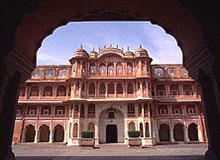 Dinner at CHOKHI DHANI � AN ETHNIC VILLAGE RESORT where the guests would be given a Royal Welcome with fireworks and all traditional gestures � enjoy the exclusive dinner with village theme - Spread over 10 acres of beautifully landscaped area for a rustic look, it is dotted with machaans & platforms where different folk artists perform concurrently. A village fair is created every evening as an ongoing celebration of the rich & vibrant cultural heritage of Rajasthan. The display of traditional huts and workmanship will take you back to the times when splendor was unpretentious. Experience the rich warmth and rustic charm of a typical Rajasthani Village at Chokhi Dhani- the festivities never end here !!! over the years it has evolved as a tasteful and authentic symbol of ethnic village life of this most colorful state in the country. Today, the name of Chokhi Dhani is synonymous with Rajasthani culture throughout the country.
Dinner at CHOKHI DHANI � AN ETHNIC VILLAGE RESORT where the guests would be given a Royal Welcome with fireworks and all traditional gestures � enjoy the exclusive dinner with village theme - Spread over 10 acres of beautifully landscaped area for a rustic look, it is dotted with machaans & platforms where different folk artists perform concurrently. A village fair is created every evening as an ongoing celebration of the rich & vibrant cultural heritage of Rajasthan. The display of traditional huts and workmanship will take you back to the times when splendor was unpretentious. Experience the rich warmth and rustic charm of a typical Rajasthani Village at Chokhi Dhani- the festivities never end here !!! over the years it has evolved as a tasteful and authentic symbol of ethnic village life of this most colorful state in the country. Today, the name of Chokhi Dhani is synonymous with Rajasthani culture throughout the country.
Dinner at Hotel and overnight.
Day 05 : Jaipur
After breakfast sightseeing of Amber fort including elephant or Jeep ride and the Pink City.
After breakfast Visit Amber fort and ride up to the fort on decorated elephant back. The Amber palace was built by the Kachhwajas when they rose in eminence and power under the Mughals. Man Singh I built it in a style to rival Mughal grandeur and opulence. Diwan-e-Aam has a double row of columns with elephant-head brackets, which had to be covered with stucco to escape the jealous eye of Jehangir. Ganesh Pol, entrance portal to inner palaces, is the most magnificent portal in Rajasthan, covered with elegant frescoes and crowned with pavilions carrying fascinating jail screens. Jai Mandir has millions of glass pieces on stucco. The same scheme of ornamentation is repeated at
Diwan-e-Khas, also built by Mirza Raja Singh. Sheesh Mahal, core of this structure, is the pinnacle of the art of ornamentation with glass. Ramparts built within walls take you to the Janana palace built by the Man Singh-I. A Baradari stands at the center of the spectacular courtyard surrounded by ladies apartments and frescoes depicting Krishna-Lila scenes. Amber is undoubtedly the grandest achievement of Rajput architecture.
Later return for Lunch at city Restaurant.
Afternoon sightseeing of Jaipur city sightseeing includes the City Palace - Sprout in the middle of the Great historical city Jaipur lies this unique palace offering a wide range of experiences. The battle-scarred walls & turrets remind of the glorious past. In the heart of the old city is former royal residence built in a blend of the Rajasthani and Mughal styles (open until 1700 hours).
City Palace is furnished and decorated with priceless works of art that form part of the Royal Collection, one of the major art collections in the world today. Its imperial Rooms form the nucleus of the working Palace and are used regularly by His highness and members of the Royal family.
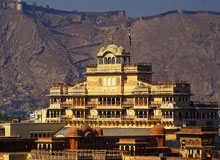 Costume museum - The Textile and Costume section of the City Palace has a fine collection of the fine loom, woven and embroidered Kashmir shawls, Kimkhabs (brocades) from Surat, Banaras and Aurangabad, the large variety of hand block prints from Sanganer and other localities, the Bandhej (tie and dye) pieces from Jaipur, Muslins from Dhaka, old embroidered rugs and tent-hangings, delicately embroidered and appliqu� rosary-bags, caps, Rath (a type of carriage) covers, Thal-Poshes (dish covers) royal paraphernalia, exquisitely embroidered costumes worn by the different Maharajas and their consorts, typical Rajasthani costumes used over the ages and delicate Zari (gold thread) and Gota (gold or silver frill) works, for which Jaipur has always been very famous. The most noteworthy exhibit is perhaps the unusually large brocaded Jama (a robe) and pajama of Maharaja Madho Singh I. The Maharaja was no doubt of gigantic physical proportions. There is an equally large white muslin pleated Jama and a huge silk covered Atamsukh worn by him, which is on display in the museum.
Costume museum - The Textile and Costume section of the City Palace has a fine collection of the fine loom, woven and embroidered Kashmir shawls, Kimkhabs (brocades) from Surat, Banaras and Aurangabad, the large variety of hand block prints from Sanganer and other localities, the Bandhej (tie and dye) pieces from Jaipur, Muslins from Dhaka, old embroidered rugs and tent-hangings, delicately embroidered and appliqu� rosary-bags, caps, Rath (a type of carriage) covers, Thal-Poshes (dish covers) royal paraphernalia, exquisitely embroidered costumes worn by the different Maharajas and their consorts, typical Rajasthani costumes used over the ages and delicate Zari (gold thread) and Gota (gold or silver frill) works, for which Jaipur has always been very famous. The most noteworthy exhibit is perhaps the unusually large brocaded Jama (a robe) and pajama of Maharaja Madho Singh I. The Maharaja was no doubt of gigantic physical proportions. There is an equally large white muslin pleated Jama and a huge silk covered Atamsukh worn by him, which is on display in the museum.
Continue your visit to �Jantar Mantar�, the astronomical observatory - At the entrance to the City Palace is Jantar Mantar, the 'Yantralaya' of Sawai Jai Singh II, the last great classical astronomer in India. The modernistic structures known as 'Yantras' are the unique creations of this astronomer-king designed by him and built by experts to observe the movements of sun, moon, planets and the stars. This is the largest of five observatories founded by him in 1716 AD. The others are at Delhi, Ujjain, Mathura & Varanasi. Its massive masonry instruments are of an extraordinary precision & can still be used to measure local time, the sun's declination, azimuth & altitude, the declination of fixed stars & planets & also to determine the time of an eclipse of the sun.
Then comes Jaipur�s signature building, the Hawa Mahal, a multi layered palace, was built by Maharaja Sawai Jai Singh II. Famous for it's beehive like structure, the Mahal is interplay of red and pink sand stone, carefully and painstakingly outlined with white borders and motifs. The palaces and forts of yesteryears, which were witness to the royal processions and splendours, are now living monuments, accepted quite naturally into the lifestyle of the people of the "Pink City".
In the evening return to your hotel. Again Gala Dinner at Raj Palace ( See the attachment). Overnight stay.
Day 06 : Jaipur � Udaipur
After early breakfast assistance and transfer to Jaipur airport to Board flight to Udaipur by 9W-3401 Dep 0715 Hrs/ Arr 0810 Hrs. On arrival assistance and transfer to Hotel.
Later sightseeing tour of Udaipur, stopping first at City Palace. Here you will marvel at rooms with mirrored walls and ivory doors, colored glass windows and inlaid marble balconies and the Peacock Courtyard. - City Palace towers over the Pichola Lake. Maharana Uday Singh initiated in the construction of the palace but succeeding Maharanas added several palaces and structures to the complex retained a surprising uniformity to the design. The entry to the Palace is from Elephant gate. It is also now the main ticket office. Balconies, cupolas and towers surmount the palace to give a wonderful view of the lake. Suraj Gokhada or the balcony of the sun is where the Maharana would grant public audiences mainly to boost the morale of the people in difficult times. The Mor Chawk is the peacock square and gains its name from the vivid blue mosaic in glass of a peacock that decorates its walls
Proceed for Evening Motor launch cruise on the placid waters of Lake Pichola. From the boat you will be able to view the city of Udaipur as it rises majestically above the lake in the middle of the Rajasthan desert. Also visit the Jag Mandir Palace - the other island palace in the middle of the lake. Spend some time at the Jag Mandir Palace.
Visit the 300-year-old Jagdish Temple and the Royal Cenotaphs of the Rajput kings.
After return Special Dinner At Durbar Hall, glittering and resplendent with chandeliers and crystal, has been the chosen venue for innumerable ceremonial and corporate events with special theme OR Dinner at Taj Lake Palace Overnight stay.
Day 07 : Udaipur - Delhi
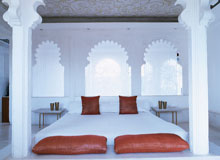 After breakfast free for own activities. Later on time assistance at transfer to Airport to Board flight to Delhi (by 9W-3318 Dep 1350 / Arr 1520 Hrs) Lunch on board. On arrival Delhi, short tour of Delhi and then Fare well Dinner with Indian Cultural Dinner Performance, Later assistance and transfer to International airport to board flight for onward destinations.
After breakfast free for own activities. Later on time assistance at transfer to Airport to Board flight to Delhi (by 9W-3318 Dep 1350 / Arr 1520 Hrs) Lunch on board. On arrival Delhi, short tour of Delhi and then Fare well Dinner with Indian Cultural Dinner Performance, Later assistance and transfer to International airport to board flight for onward destinations.
Day 08 : Depart for Home Country
Flight for onward destinations.
|